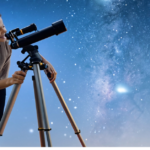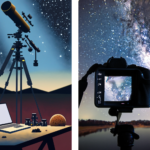Table of Contents
What is landscape astrophotography?
Landscape astrophotography is a form of photography that combines an astronomical element with a natural scene. An obvious example is a scene such as a mountain range or rocky outcrop with an imposing shot of the Milky Way above.
You can see these kinds of astrophotos being shared a lot online, as they are very popular. Most photographers will have tried, at one time or another, to take this kind of astrophotography shot.
Other great examples of landscape astrophotography might feature interesting or rare astronomical events such as meteor showers or comets. The choice of the background landscape is totally up to the photographer, and this is where an eye for creativity comes into play. Because of this, each of these two elements can make any landscape astrophoto very unique and truly a work of art.

The aim of this kind of astrophotography is to contrast and appreciate both the natural world and the wonders of the universe that we can see in the night sky. The picture above introduces one of the most amazing backdrops for any astrophoto: mountains. How incredible is that?
Learn more about how to take landscape photos at laanscapes.com
Why it’s a popular genre of photography
The reason why landscape photography is so popular is probably because of its appeal to both nature lovers, and art lovers in general, as well as to those interested in space or astronomy. For photographers, it is probably also a chance to try something new and a challenge to compose such an interesting photo.
Social media has also increased the exposure of astrophotography to a much wider number of people, and this also creates a desire for those interested in photography to take and share these kinds of astrophotos.
How popular is it?
There are not actually any hard figures on this, although there are many articles about the topic. I have tried to show how popular landscape astrophotography is by looking at and compiling some research from Instagram, Google Search, and Amazon.com. My results are below.
| Keyword | Google Search | Amazon.com books | |
| photography | 7,050m | 1,000m | 60,000+ |
| astrophotography | 12.2m | 5m | 935 |
| landscape astrophotography | 5.36m | 5000+ | 156 |
What do the above results tell us? We know that photography is a very popular interest, and we can see by the number of search results on Google that it’s hugely popular!
Astrophotography is a niche within photography and therefore, as expected, is much smaller but still very popular, with 12.2 million search results on Google and 5 million posts on Instagram!
Landscape Astrophotography is still popular as a category on its own, as can be seen above with 5.36 million web pages in Google Search Results and more than 5,000 posts on Instagram.
Planning and Preparation for Landscape Astrophotography

To get a great landscape astrophoto, you need to spend some time planning your shot. The photograph above by Ken Cheung shows a good example of how both a landscape and a foreground image of his camera and tripod perfectly complement the Milky Way above. This is truly great work!
Here are some important things to consider when planning your shot:
- Make sure to choose a place with low light pollution.
- Make sure you have a clear view of the direction you will be shooting.
- Think about the composition and framing of your shot.
- Next, you will need to choose your exposure settings carefully.
- A sturdy tripod is essential, as the slightest movement can spoil your shot.
- If you are taking repeated shots, you’ll need a shutter release so that you can avoid camera shake by activating the shutter remotely.
- Use an intervalometer so that you can set the length of exposure, the number of shots, and the interval between shots.
- Consider the moon phase because if it is near a full moon, there will be extra illumination that may spoil your shot. The position of the moon will also determine how much this light will affect your picture.
- Check before you go out what kind f weather is expected, paying particular attention to cloud cover and wind.
- Start your session early so you can get set up and try test shots before going ahead. This is also a good idea because sometimes a problem you didn’t expect can pop up, and if there is time, you can fix it and you won’t have wasted your evening.
With proper planning and preparation, there is a much better chance that the picture you end up with will be far more impressive than if you take potluck.
The essential equipment needed for landscape astrophotography
We’ve already mentioned some of the obvious items, such as a shutter release or intervalometer and a camera, so here is a short list of some of the items you should be sure to take with you:
- filters appropriate for your location and target.
- a portable battery to charge your equipment and devices if necessary.
- a headlamp or other light that will help you do what you need to do in the dark.
- an application on your phone such as Sky Safari to navigate the skies or find an object you want to shoot.
- For any external lighting, you might need to light up your landscape so that it becomes clearer in your shot.
- some kind of tracker or mount if you plan to take longer exposures.
- spare cables or batteries just in case something goes wrong!
Following these tips will ensure you have an enjoyable and successful evening and photos that will be amazing!
Techniques for capturing clear and stunning photos
Night photography brings its own challenges. One of these is the necessity of taking longer exposures and possibly the need to track the stars. If you do have a tracker or mount, you’ll also need to polar align it so that tracking gives you round stars.
You should experiment with the lighting you use to get different effects. You should also try shooting from different angles to get various perspectives on your scene. Later, you may prefer one particular viewpoint and be happy that you tried different angles.
Post-processing is an art in itself and can really set the mood of your final image. There are many techniques you can try to sharpen or enhance the picture you have taken. You may be really surprised at how much difference these can make!
Each time you shoot landscape photography, try something different and push your processing skills further so that you can produce even better astrophotos. The possibilities are truly endless!
How to capture foreground and background elements
In any landscape photography, the foreground or background is very important because it not only makes your photograph more interesting but also forms a major part of your composition. You should choose your landscape feature carefully to complement your astronomy target and create an image that is both artistic and balanced. In this sense, it is like painting a picture.
The landscape features should also lead your eye naturally to the object in the sky and not overwhelm it.
You’ll need to photograph your foreground or background in one shot, but the sky portion may need to be stacked with several images taken with longer exposures.
Post-processing tips for Landscape Astrophotography
As we have already said, the processing step is very important and can make or break your image and the effect it has on the viewer. You’ll need the software and the skills to pull this off and create a pleasing final image.
I normally use Photoshop for my post-processing, but you will also have to use a stacking program such as Sequator that can separate the foreground or background from your sky and stack the sky, leaving the landscape untouched. You don’t want to include the landscape in your stacking images because you tracked the stars, and therefore each image will have a different sky-to-landscape orientation. You need to freeze the landscape element and align and stack only the sky portion on top of the other images.
Some of the processes you will need to do will be to remove gradients and light pollution, stretch your images, and set saturation and colour levels. Your black point and white balance will also need to be set to enhance your image’s contrast.
Conclusion
After the planning, shooting, and processing of your images, you should have an incredible image that has the two elements of nature and the cosmos balanced in an interesting composition. The result will be something to be proud of and something that will inspire awe in others! Good luck with your landscape astrophotography!






